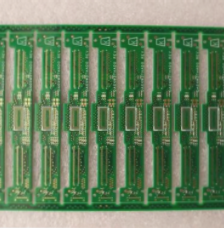PCB has identified the following five common silver-plating defects through collaboration with Yaoshui merchants, mechanical equipment manufacturers, and on-site research on PCB circuit boards. By analyzing these issues and identifying some preventive and corrective measures, the multi-layer PCB prototyping factory has been able to overcome challenges and improve qualification rates. These findings are now shared as follows:
1: **Javani Multilayer Circuit Board Copper Bites**
This issue can be traced back to the copper electroplating process. It has been found that if the target is a high aspect ratio deep-hole or buried-hole plated board, the problem tends to manifest more clearly. In the multilayer PCB process, the stripping of metal material inhibitors (such as pure tin layers) and copper during the etching process is a critical factor. If the etching and side etching conditions are not properly controlled, excessive etching can lead to gaps, which may allow electroplating solutions and micro-etching solutions to remain in the process, exacerbating the issue.

1: **Green Paint Project and Gaps in Multilayer PCBs**
The primary issue arises from the green paint process, where side erosion and film relief patterns caused by the condition of the green paint are most likely to lead to gaps. If the residual pads, rather than negative side corrosion, can eliminate the copper affected by corrosion, this will improve the appearance of the green paint. The green paint can then be removed by the hard bottom after it has been fully grounded. To optimize the copper electroplating process, especially in terms of uniform mixing and deep hole copper plating, ultrasonic and high-power agitation (such as Educor) can be employed to enhance fluid quality and ensure even copper deposition. For PCB immersion in a custom silver plating process, the copper micro-etching rate at the front end must be tightly controlled. A smooth copper surface can also reduce the appearance of green paint. Finally, the silver tank should not excessively reflect copper; it should maintain a neutral pH, and the board speed should not be too high. Ideally, the silver layer should be as thin as possible, with a focus on achieving optimal silver crystal formation to ensure effective anti-coloration properties.
2: **Improving Color Retention in Multilayer PCBs**
To improve the coating quality, it is essential to increase relative density and reduce porosity. When packaging goods, sulfur-free paper and multi-sided sealing should be used to block carbon dioxide and sulfur in the air, thus minimizing color variation under different light sources. Additionally, the average storage temperature should not exceed 30°C, and the environmental humidity must be kept below 40% RH. It is also recommended to implement a priority-plus current policy to prevent prolonged storage, which can lead to difficulties in the manufacturing process.
3: **Reducing Ionization Pollution on PCB Surfaces**
If it is not possible to lower the ion concentration in the silver plating bath without affecting coating quality, the ionization of the PCB surface should be reduced as much as possible. During the cleaning process, pure water should be used before drying, with a brief immersion for one minute to reduce adhesion and ionization. For assembled boards, cleanliness testing is crucial, and it is important to minimize residual ionization on the PCB surface to meet industry standards. Properly documented experiments should be saved for future reference.
4: **Enhancing Copper Quality on Silver Surfaces of Multilayer PCBs**
Before silver plating, it is essential to carefully manage all preparatory steps, such as conducting a “waterproof” test (WaterBreak test refers to water-solubility) following micro-etching of the copper surface. Bright copper spots may indicate contamination on the copper surface. A slightly corroded copper surface, on the other hand, is ideal as it is clean and well-prepared. This state should be maintained for at least 40 seconds without water interruption. Additionally, production line equipment should be regularly maintained to ensure consistent water solubility for achieving an even silver plating layer. To achieve the best silver-plated finish, continuous DOE (Design of Experiment) testing should be conducted to evaluate factors such as leaching time, liquid temperature, mixing, and particle size. For thick steel plates and HDI micro-buried boards, the silver plating process can also benefit from ultrasonic and strong external forces to improve the quality of the silver layer. Enhanced mixing of tank fluid improves the wetting and exchange capacity, especially in deep and buried holes, which is beneficial for all wet processing stages.
5: **Improving Microvia Spot Welding in Multilayer PCBs**
Interface microvias remain challenging to improve due to silver plating defects, as the root causes are not yet fully understood. However, some contributing factors can be identified. To reduce the occurrence of microvias in the welding process, it is essential to minimize related factors in the pre-solution stage. These factors are closely tied to the thickness of the silver layer, so reducing the silver layer thickness is crucial. Additionally, the micro-etching process should avoid making the copper surface overly smooth. Achieving a uniform, thin silver layer is key. The composition of organic compounds in the silver layer can be evaluated by analyzing the purity of the silver. To do so, a more extensive sampling process is required, ensuring that the silver content is at least 90% by molecular ratio.
If your have any questions about PCB ,please contact me info@wellcircuits.com



